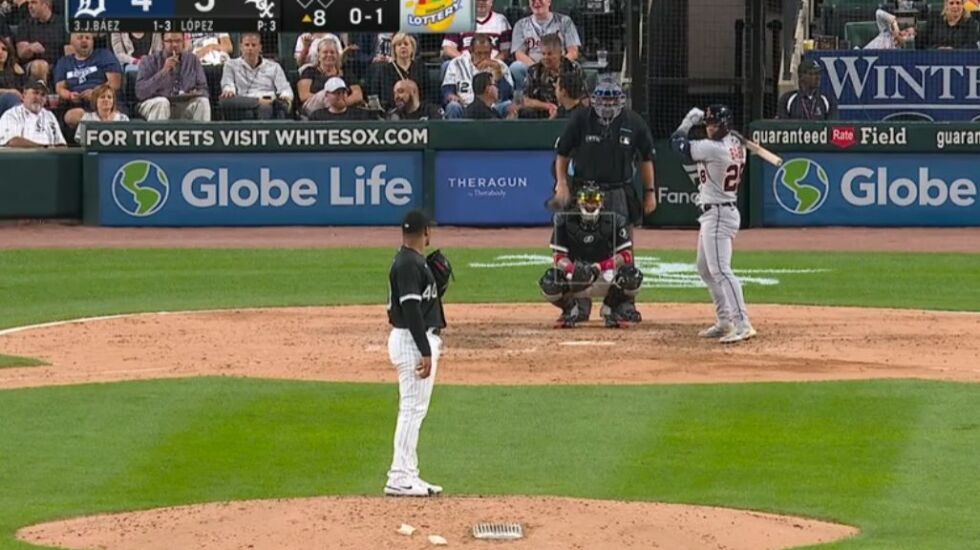
Most of the talk around baseball is how the new rules will affect the game. But what about the broadcasts?
With a pitch clock and pickoff limit, announcers and analysts will have less time to talk – though that might be for the better. The adage “Don’t start a story with two outs” might become “Don’t begin a thought with five seconds left.”
Sports viewers are accustomed to shot clocks in the NBA and play clocks in the NFL. They’ve been woven seamlessly into broadcasts, even appearing on the playing surface. But never have we seen a clock on a baseball broadcast like we’ll see starting this weekend with the opening of spring-training games.
NBC Sports Chicago will incorporate one in its existing score bug for White Sox games, the first of which is Saturday. ESPN will do the same for games it will air next week. The Cubs’ Marquee Sports Network figures to experiment with the clock, but it declined to comment on its plans.
NBCSCH will try out two designs during its six-game exhibition schedule. One has the clock inside the bug, and the other has it in a circle to the left of the graphic.
“Either way, it’s not going to be floating somewhere else,” said John Schippman, the network’s vice president of content. “It’s going to be all tied up together so it doesn’t distract the viewer or take up any more video space. And it’s not some kind of flashy animation. We want it up there to educate people, but we’re not saying ‘Look at the pitch clock’ every time somebody gets on the mound.”
NBCSCH won’t switch between the two clocks during games so as not to confuse viewers. It will stick with its preference throughout the regular season. It also will make sure producer Chris Withers and broadcasters Jason Benetti and Steve Stone aren’t shy about explaining the new rules.
“MLB has done well explaining everything, but at the same time, we’re encouraging everybody to over-explain it,” Schippman said. “We need to explain that it’s for the pitcher but it’s also for the batter because he has to be in the batter’s box at a certain time.”
Phil Orlins, ESPN’s head of baseball production, said the network put the clock in the lower-right corner of its score bug, where the pitch count is. Orlins tried putting it with the pitcher’s name on the line beneath the team’s logo and score, but it didn’t have the impact he was looking for.
“We looked at changing it from the pitch count to the clock at a certain time,” Orlins said. “We opted to keep the pitch count, and when the clock hits a certain time, it would slide in and the pitch count would slide over.
“If it gets to zero without a pitch, there’ll be another spot with the pitcher’s name that’ll say with a bright-colored background ‘pitch clock violation.’ And then the spot where the count and baserunners is located would go to a ball or a strike for two or three seconds before it goes back to the pitch count.”
The tricky part of broadcasting spring-training games is that not every ballpark is equipped the same. ESPN will air four games next week, three of which are in stadiums with the technology to send data, such as the pitch clock, to its score bug. For the other game, Thursday at the Red Sox’ facility, ESPN will display the clock the old-fashioned way by aiming a camera at it.
Orlins said MLB likely will make the clock available for display on the back of the pitcher’s mound, where some networks display advertising. But he expects ESPN to keep it in the score bug. He also expects the score bug to eventually track pitchers’ disengagements (pickoff attempts or step-offs), but the network hasn’t designed a graphic yet.
This year, players won’t be the only ones in need of spring training. Broadcasters, producers and technicians will have plenty to figure out.
“What we see on Saturday and in spring training may be different from what we see on Opening Day,” Schippman said. “Early on, it may not be perfect, but it’s new to MLB and us. The NBC Sports Group has done a tremendous job prepping graphics and talking points for the White Sox broadcast to make it easier for the viewers to understand the new rules.”
PITCH CLOCK AT A GLANCE
Time between batters: 30 seconds.
Time between pitches: Bases empty, 15 seconds; runner(s) on base, 20 seconds.
Batters must be in the box and alert to the pitcher by the eight-second mark.
Pitchers have two disengagements (pickoff attempts or step-offs) per plate appearance. It resets if a runner advances during the plate appearance.
If a third pickoff attempt is made and is unsuccessful, the runner advances one base.
Source: MLB






